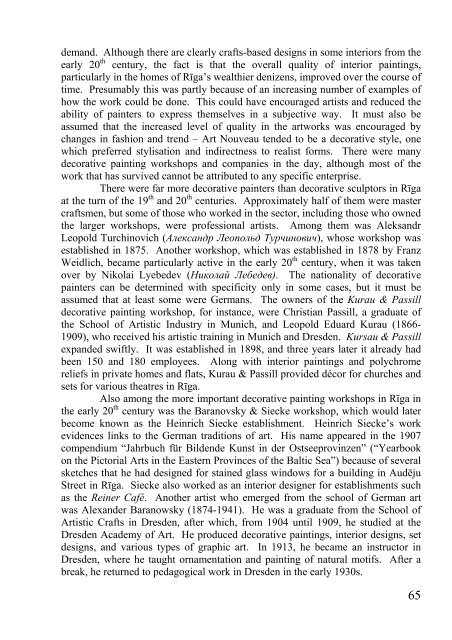SILVIJA GROSA JŪGENDSTILA PERIODA PLASTISKAIS UN ...
SILVIJA GROSA JŪGENDSTILA PERIODA PLASTISKAIS UN ...
SILVIJA GROSA JŪGENDSTILA PERIODA PLASTISKAIS UN ...
You also want an ePaper? Increase the reach of your titles
YUMPU automatically turns print PDFs into web optimized ePapers that Google loves.
demand. Although there are clearly crafts-based designs in some interiors from the<br />
early 20 th century, the fact is that the overall quality of interior paintings,<br />
particularly in the homes of Rīga’s wealthier denizens, improved over the course of<br />
time. Presumably this was partly because of an increasing number of examples of<br />
how the work could be done. This could have encouraged artists and reduced the<br />
ability of painters to express themselves in a subjective way. It must also be<br />
assumed that the increased level of quality in the artworks was encouraged by<br />
changes in fashion and trend – Art Nouveau tended to be a decorative style, one<br />
which preferred stylisation and indirectness to realist forms. There were many<br />
decorative painting workshops and companies in the day, although most of the<br />
work that has survived cannot be attributed to any specific enterprise.<br />
There were far more decorative painters than decorative sculptors in Rīga<br />
at the turn of the 19 th and 20 th centuries. Approximately half of them were master<br />
craftsmen, but some of those who worked in the sector, including those who owned<br />
the larger workshops, were professional artists. Among them was Aleksandr<br />
Leopold Turchinovich (Александр Леопольд Турчинович), whose workshop was<br />
established in 1875. Another workshop, which was established in 1878 by Franz<br />
Weidlich, became particularly active in the early 20 th century, when it was taken<br />
over by Nikolai Lyebedev (Николай Лебедев). The nationality of decorative<br />
painters can be determined with specificity only in some cases, but it must be<br />
assumed that at least some were Germans. The owners of the Kurau & Passill<br />
decorative painting workshop, for instance, were Christian Passill, a graduate of<br />
the School of Artistic Industry in Munich, and Leopold Eduard Kurau (1866-<br />
1909), who received his artistic training in Munich and Dresden. Kursau & Passill<br />
expanded swiftly. It was established in 1898, and three years later it already had<br />
been 150 and 180 employees. Along with interior paintings and polychrome<br />
reliefs in private homes and flats, Kurau & Passill provided décor for churches and<br />
sets for various theatres in Rīga.<br />
Also among the more important decorative painting workshops in Rīga in<br />
the early 20 th century was the Baranovsky & Siecke workshop, which would later<br />
become known as the Heinrich Siecke establishment. Heinrich Siecke’s work<br />
evidences links to the German traditions of art. His name appeared in the 1907<br />
compendium “Jahrbuch für Bildende Kunst in der Ostseeprovinzen” (“Yearbook<br />
on the Pictorial Arts in the Eastern Provinces of the Baltic Sea”) because of several<br />
sketches that he had designed for stained glass windows for a building in Audēju<br />
Street in Rīga. Siecke also worked as an interior designer for establishments such<br />
as the Reiner Café. Another artist who emerged from the school of German art<br />
was Alexander Baranowsky (1874-1941). He was a graduate from the School of<br />
Artistic Crafts in Dresden, after which, from 1904 until 1909, he studied at the<br />
Dresden Academy of Art. He produced decorative paintings, interior designs, set<br />
designs, and various types of graphic art. In 1913, he became an instructor in<br />
Dresden, where he taught ornamentation and painting of natural motifs. After a<br />
break, he returned to pedagogical work in Dresden in the early 1930s.<br />
65












